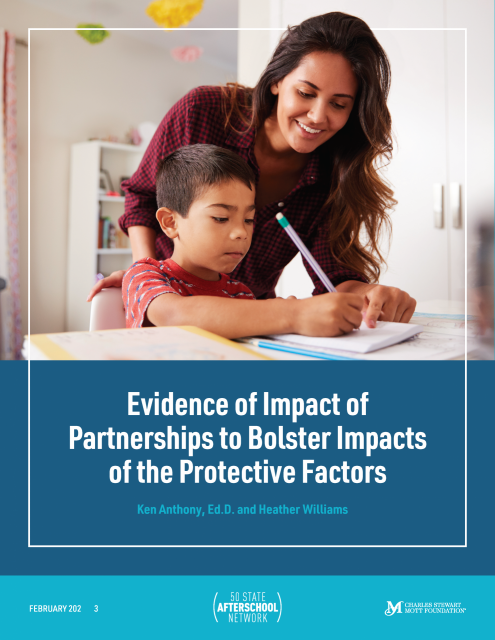Promoting Protective Factors in California’s Afterschool Programs
June 2021
This report was created by WestEd and commissioned by the California AfterSchool Network.
The report, drawing on data from the California Healthy Kids Survey (CHKS), examines the extent to which afterschool programs* may help foster more protective factors among its participants compared to their peers who were not program participants.
Below are some excerpts from the report that outline the Protective Factors Framework and key findings.
A Protective Factors Framework
Research on protective factors and resilience emphasizes the importance of three broad areas of environmental support:
- Caring Relationships. A single positive, trusting relationship with a caring adult can make an enormous difference in the ability of children to overcome a host of negative life experiences.
- High Expectations. Youth need to experience high-expectation messages that convey adults believe the youth can and will succeed, that they won’t give up on them but will encourage and help them to do their best, nurturing each youth’s unique strengths and pathways to success.
- Meaningful opportunities for participation and contribution. Youth need to be engaged in activities and decision-making opportunities that contribute to their sense of autonomy and control, give them voice, increase their involvement in school/community, and engage their interests.
When these three protective factors are present in any environment—families, schools, communities, or afterschool programs—they work together in a dynamic process to create a climate that is optimal for fostering resilience and positive youth development. They are essential to meeting the basic developmental needs felt by all people of all ages for safety, love, belonging, respect, a sense of mastery, personal power, and meaning in life (autonomy, belonging, and competence). When these needs are met, the negative effects of trauma, adversity, and/or other stressors are mitigated, and people are more likely to
- Feel connected to school, society, and/or family (social bonding);
- Develop the social-emotional competencies and other personal assets (strengths)—commonly referred to as Social and Emotional Learning (SEL)—that have been linked to successful learning and development, such as self-awareness, empathy, problem-solving, and emotional regulation skills; and, as a result,
- Avoid engagement in risk behaviors that are barriers to learning and healthy development and experience positive academic, personal, and health outcomes.
Key Findings
These findings add to the large body of literature documenting the value of afterschool programs in fostering positive youth development and successful youth outcomes by creating environments rich in protective factors, especially for youth in high-poverty, marginalized communities who face multiple risk factors.
The findings of the current study support the positive impact that California’s extensive system of programs is having among secondary school participants. As there are still considerable unmet program needs within the state, this study adds to the evidence for further expanding the system, particularly among high schools, so that more students can experience its benefits.
- Students who attended the afterschool programs reported significantly higher levels of meaningful participation in school compared to students who did not attend the afterschool programs. The positive effect of afterschool attendance on meaningful participation was true for both school levels (i.e., students in grades 7 and 9/ 11). There was a greater difference in ratings of meaningful participation between afterschool participants and non-participants among high school students as compared to the younger students. The effect size was larger for high school students (d = 0.52), than for seventh graders (d = 0.26).
- Participants in afterschool programs at both school levels also reported significantly greater levels of school connectedness (e.g., I feel close to people at this school), academic motivation (e.g., I work hard to try to understand new things at school), caring adult relationships (e.g., At my school, there is a teacher or some other adult who really cares about me) and high expectations (e.g., At my school, there is a teacher or some other adult who believes that I will be a success), as compared to non-participants. The effect size was largest for high school students on measures of school connectedness (d = 0.18), caring adult relationships (d = 0.19), and high expectations (d = 0.18), indicating meaningful differences between participants and non-participants.
- These results are consistent with prior research and hypotheses on how afterschool programs can help foster school-based protective factors. Several features of the state program might contribute to these positive results. As noted, youth development promotion is central to CDE’s strategic plan for expanded learning and its program requirements, including implementation of The Quality Standards for Expanded Learning in California. These Quality Standards charge programs to create safe and supportive environments that help meet the needs of the whole child, engage them in active learning, build skills, gives voice to students, fosters leadership, promotes student well-being, and builds partnerships with the school, family, and community to achieve these goals.
-
High School Students. Across the indicators, the differences between participants and nonparticipants were notably greater among students in high school, thus, the protective supports and opportunities provided by afterschool programs may have a greater effect on high school students. California was the first state to begin funding afterschool programs for high school students, but there are still far fewer high school programs (317) than programs for elementary and middle school students (4,200). These findings support their value and argue for their expansion, especially in helping fulfill students’ developmental needs.
Access the Full Report
*Afterschool participation. Afterschool participation was captured via the CHKS. For this report, we identified and compared results for students who did not report participating in their school’s afterschool programs and students who participated regularly, (3-5 days per week), within schools that received program funding from the CDE Expanded Learning Division (EXLD). We cannot be certain that all the students in these schools who reported attending afterschool were participating in the CDE-funded programs versus another program. Students could even be participating in several programs. However, the question does specify attending “your schools’ after school program” and it is very likely that it would be the CDE program, particularly for a student who participated frequently.
Related Content
Evidence of Impact of Partnerships to Bolster Impacts of the Protective Factors
February 2023
A new brief entitled Evidence of Impact of Partnerships to Bolster Impacts of Protective Factors (By Heather Williams, of the California AfterSchool Network and Ken Anthony, Ed.D., Associate Executive Director at the Connecticut After School Network) explores how protective factors identified through resilience research play a crucial role in positive child and youth development, mitigating negative experiences.
Partnerships are essential for supporting whole child recovery. Afterschool programs, acting as community hubs, can unite stakeholders to foster resilience and reduce the impact of trauma on children and youth. Emphasizing protective factors and positive youth development can support children’s social and emotional skills post-pandemic.
This blog post from Afterschool Alliance explores the brief further, also sharing a logic model helps unpack some of the potential impacts and implications community-wide partnerships can have on the success of children and youth.



